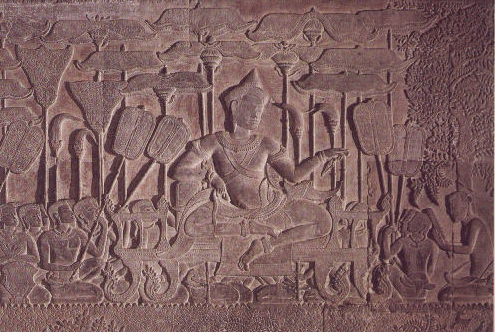|

Suryavarman II, son of Ksitindradity and Narendralakshmi, Khmer king renowned as a religious reformer and temple builder. Under his rule the temple of Angkor Wat, the world's largest religious structure, was constructed.
Suryavarman II defeated rival claimants, Harshavarman III and Dharanindravarman I, to the throne and established sole rule over Cambodia, reuniting the country after more than 50 years of unrest. He was formally crowned in 1113, with his guru, the powerful priest Divakarapandita, presiding. The King was a religious reformer who blended the mystical cults of Vishnu and Siva, supreme Hindu deities, and promulgated Vaisnavism as the official religion, rather than Buddhism, which had briefly flourished under his predecessors.
Angkor Wat, dedicated to Vishnu, was begun in the early year of Suryavarman's reign and was not finished until after his death. Surrounded by a wall and a moat, the building is decorated with sculptures portraying Suryavarman as Vishnu; he is shown reviewing his troops, holding audiences, and performed other functions of a sovereign. Suryavarman also sponsored the construction of several other temples in the style of Angkor Wat. He completed or at least decorated and furnished the massive temple of Wat Phu (in present day Laos), which was started by Suryavarman I.
In 1116 Suryavarman resumed diplomatic relation with China, which had been broken early in the reign of Jayavarman II, by sending tribute to Chinese Imperial Court.
From 1123 until 1136 Suryavarman II waged a series of unsuccessful campaigns against Dai Viet, the Vietnamese kingdom that had asserted its independence from China in 939. In 1128 he is said to have led some 20,000 soldiers against Dai Viet at Nghe An, but he was defeated and driven out. A few months later, Suryavarman's fleet of 700 vessels began a long harassment along the coast in the Gulf of Tonkin. Suryavarman coerced the kingdom of Champa to assist him in these efforts. In 1132 the combined forces of Cambodia and Champa again invaded Nghe An, but were driven out. In 1136 the Cham king, Jaya Indravarman III made peace with the Dai Viet, refused to join Suryavarman in a new campaign, which ended disastrously for him
In 1144 Suryavarman II invaded and deposed the Cham king, who he considered a treachery. He annexed Champa in the following year, and put his brother-in-law, Harideva, on the Cham throne at Vijaya. However in 1147, the Chams rallied around their new king, Jaya Harivarman I. When Suryavarman heard of the new Cham king, he sent Cambodia and Chams from Vijaya forces to conquer him. Jaya Haravarman I met them at chaklyang and annihilated the attacking forces. The next year, a larger army was sent against the Cham king; it was defeat at Kayev. With a series of military successes, Jaya Harivarman I marched northward seized Vijaya and totally destroyed the Cambodian and Cham forces at Mahisa. Harideva and his troops were all killed.
Suryavarman II died in 1150 in the midst of a new campaign against Champa. He received the posthumous name of Paramavishnuloka. As builder and religiou reformer, Suryavarman II rates among the greatest of Khmer kings. His foreign wars were not so successful. "..then in 1035 'saka (A.D. 1113), His Majesty Suryavarman, grandnephew on the maternal side of Their Majesties Jayavarman and Dharanindravarman, mounted on the throne and invited the Vrah Guru to proceed to the royal anointment. The King then performed the sacrifices, beginning with the sacred mysteries, had the solemn fetes accomplished, and gave rich presents, such as palaquins, fans, fly-swatters, crowns, buckles, pendants, bracelets and rings." Inscription gives an account of the inauguration of Suryavarman II.
"Under the Sung dynasty, at the twelfth moon of the sixteenth year ching-ho (A.D. 1116), the king of Chenla sent an ambassadors, two great dignitaries of the kingdom. They came with a suite of 14 persons. They were given court clothes and then(one of the ambassadors) said to the Emperor: 'From afar, the nations of the south and west have their regards fixed on the changes of fortune which operate on the fate of the people by the sacred institutions of the Empire. Scarcely have we arrived to prove our great attachment nor demonstrate our gratitude, we solicit permission to appear at the Imperial disposition with the clothes you have given us.' The Emperor gave them all they asked and ordered that all the details of their reception should be recorded in the official annals. The following year (1117), at the third moon, these foreigners took their leave and returned to Chenla. The second year suan-ho (1120), new envoys of the same country arrived again. Their king received investiture with honors equal to those accorded to the king of Chen-Ching (Champa). The third year kien-yuen (1128), the Emperor conferred high dignities on the king of Chenla, who was recognized great vassal of the Empire. Some difficulties relative to the affairs of commerce were then examined and regulated." Chinese account of Suryavarman II's embassies. |

